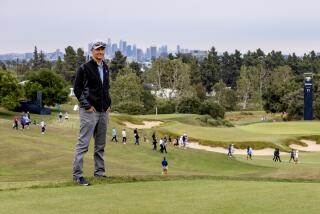Turnberry Course Has Served British Nobly in Both Peace and War
- Share via
TURNBERRY, Scotland — Hugh Kennedy, 66, sat in the parlor of his Girvan home and told his stories.
Eight miles up the road, around many bends, on the links of Turnberry, the British Open golf tournament was about to go on. Forty-four years before, on the very same land, something far more urgent was happening.
The Royal Air Force’s Torpedo Training Unit was stationed there. The golf course by the sea had been converted into a World War II air base--just as it had been in the World War before.
This time there were 1,200 airmen on the acreage, among them young Cpl. Kennedy, D/F (Direction/Finder) of the RAF signal corps, who monitored aircraft with a fairly primitive form of radar from the control tower by day and who slept in the golfers’ clubhouse at night.
With the war escalating through Europe, Kennedy was called away from his job in Lanarkshire, 60 miles from Turnberry. He was a fell-mongerer, meaning he pulled the wool from dead sheep, by hand. It was hard work, often leaving the fell-mongerer with bleeding hands, but the dead sheep had to be plucked cleanly, not just sheared, so the skins could be made into leather.
Kennedy spent four years based at Turnberry, right to the end of the war, while others mastered their aviation and gunnery and moved on to active combat.
Many were killed. Some were killed before they ever left the base. Others, with burns from test-flight crashes, were submerged into oil baths, small swimming pools of crude, to ease their pain.
There were happier times. Kennedy was captain of the camp soccer team and a saxophonist in the base’s dance band. He kidded that those two skills alone were responsible for keeping him on the premises for the duration of the war.
This particular Scotsman was not a golfer, then, and therefore did not mourn the torn-up, tar-covered links as many others around him did. But years later, after the war, Kennedy took up the game and found himself playing a round at Turnberry a fairway away from a visiting dignitary from America, name of Eisenhower.
“I nearly hit one of your dead Presidents,” was how Kennedy recalled it. “I was noted for my wayward driving, you know.”
He also was not a flier.
“I do have an experience of flying, and I must tell you about that,” he said. “I think that most of the people who were with the Royal Air Force wanted the experience of flying. And I was going to take to the air one night in the summer of nineteen and forty-two.
“The planes were going in and out, and I said: ‘When can I go up in one of those?’ And I was told: ‘Sit out there for about half an hour, and we’ll give ye a call.’ And during that very half an hour, there was an accident. And I smelled burning flesh that day.
“Two planes collided. One was a Beaufort. I don’t know what the other one was. Might have been a Hampden, this one. I think most of the spare crew rushed the wreckage, and some ventured a bit further, started trying to pull people out of the planes. And we all could smell that flesh burning. I was sick for three days.”
Cpl. Kennedy, stationed at an air base, had never been up in an airplane.
“You can imagine, I didn’t go for my ride that day,” he said.
He did have to testify at a formal inquiry into the accident two days later, attending it in a wrap and cap. There was a big game that day, so underneath his tunic, he was dressed for soccer.
The general mood on the base was not grim. Airmen were issued bicycles and enjoyed long rides around the converted golf club, pausing only when spotting an officer, for whom they had to turn their heads to the right and nod in lieu of a salute.
As discipline went, it was rather dangerous, since the bikers had to divert their eyes from the road. But anyone who did not comply was forced into “jankers,” the British version of KP.
Some of the camp’s lightheartedness eased the horror, of which there was enough. Most of the pilots were young and inexperienced, and crashes were common. One night, after one flyer had nose-dived into the Irish Sea, five others took off to search for him, and four of them were killed.
To this day, 44 years later, small chunks of aircraft wreckage periodically are found floating near the shore, alongside the golf holes of Turnberry.
Jimmy McCubbin, 71, was one of those who longed for the return of golf. He had been a member of the Turnberry greenskeeping crew for two years when he got the bad news one night in 1939. The government was commandeering the golf course, for the second straight war.
Turnberry was to be turned into a military air station, just as it had been in 1916 for the Great War, when pilots were trained in Sopwith Camels and Pups and other small planes, for aerial combat against the likes of Baron Manfred von Richthofen of Germany, who eventually shot down 80 of the Allies.
Once again, the lovely 18-hole course, carved out of this vast seaside property in 1901, would be used for something more weighty than golf. Turf would be dug, earth moved by steam shovel and tractor, new foundations planted, new Tarmac laid.
Runways would replace fairways. Quonset huts would dot the land. Tents would be staked on what used to be greens. Planes would be everywhere, on three airstrips covered with six inches of concrete. Turnberry golf club was becoming torpedo junction.
“I was heartbroken,” said McCubbin, now retired after 45 years, on and off, of grooming Turnberry’s greens. “Literally. I saw the runways being put down on the golf course, the bulldozers plowing it up. I thought it was gone forever.”
There had been similar thoughts in 1916, when airplanes landed directly on the grass. The golf course, it was feared, would never be the same. But the cause was so good, and the government so powerful, no one dared say nay.
There is a sword carved into the spire of the stone monument that now graces a grassy knoll above the 12th green, looking out toward the sea. Engraved underneath are the names of 35 airmen who served during World War I, troops who spent time at the Turnberry base, men killed in the line of duty.
Another side of the memorial is inscribed:
To the Memory (Of) The Officers Non-Commissioned Officers And Men Of the Royal Flying Corps Royal Air Force And the Australians And United States Air Services Who Gave Their Lives For Their Country While Serving in the School Of Aerial Gunnery and Fighting At Turnberry MCMXVII-MCMXVIII Their Name Liveth For Evermore Off in the distance, toward the ninth fairway, stands a lighthouse. On a far-off hilltop is the Turnberry Hotel, picturesque, white and sprawling with an endless red roof, built in 1907 to lodge the fashionable guests who had come to play southwestern Scotland’s popular new links.
It is a short walk in any direction to scarred, tarred paths, remnants of runways, black patches that appear throughout the hilly course. Dandelions and clover poke through the tar, 50 yards or less, in some cases, from immaculately manicured fairways.
“Are ye familiar with the course?” asks McCubbin, who returned to his greenskeeping at war’s end.
“No? Well, now. Take the 18th green. There is only 18 inches of soil there to this day. The green sits on top of a dispersal point--parking places, you would call them. We had to rip up the concrete and leave it in a pile. I remember in 1960, we wanted to rebuild the championship tee at the 17th, so we went to the old piles, carried the concrete from the old runways, and built the foundation for our new tee with it.”
The government helped pay to renew the course. Philip Mackenzie Ross, the golf architect, designed the restoration. Jimmy Alexander, the superintendent of grounds--”87 and still with us today,” said McCubbin--supervised the work.
They thought they could return Turnberry to what it was, a quaint links course. “But they never imagined that they were making a British Open kind of course,” McCubbin said. “They didn’t realize what a good course it was until some professionals came and started to tell them so.”
By 1977, Turnberry was the site of the British Open. By 1986, upon the tournament’s return, some of the world’s greatest professional golfers were describing it as the toughest course they had ever played.
Pilots had once called it that, having descended onto makeshift runways in dreary weather, their planes wobbling like kites in the air pockets off the Scottish coast.
Some lived to tell about it. Some who saw pilots crash lived to see Turnberry return to what it was meant to be, a place to play golf. They hope it liveth as such, forevermore.
More to Read
Sign up for Essential California
The most important California stories and recommendations in your inbox every morning.
You may occasionally receive promotional content from the Los Angeles Times.













